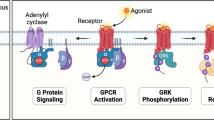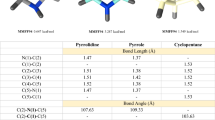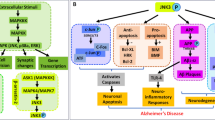Abstract
The sigma-2 (σ2) receptor was discovered nearly 40 years ago and was recently identified as the Transmembrane Protein 97 (TMEM97, also known as MAC30 (Meningioma-associated protein)). Aberrant σ2 activity has been linked to diseases and conditions such as schizophrenia, Alzheimer’s disease, neuropathic pain, traumatic brain injury, and cancer. The utility of σ2 as a therapeutic target is currently under investigation in numerous laboratories. Herein, we report on the synthesis and evaluation of a series of novel, functionalized γ-butyrolactones that are potent σ2 receptor ligands.




Similar content being viewed by others
References
Martin WR, Eades CE, Thompson JA, Huppler RE. The effects of morphine and nalorphine-like drugs in the non-dependent and morphine-dependent chronic spinal dog. J Pharm Exp Ther. 1976;197:517–32
Su TP. Evidence for sigma opioid receptor: binding of [3H]SKF-10047 to etorphine inaccessible sites in guinea-pig brain. J Pharmacol Exp Ther. 1982;223:284–90. https://doi.org/10.1007/s00044-020-02574-9
Khazan N, Young GA, El-Fakany EE, Hong O, Caliigaro D. Sigma receptors mediated the psychotomimetic effects of N-allylnormetazocine (SKF-10,047), but not its opioid agonistic-antagonistic properties. Neuropharmacology. 1984;23:983–7. https://doi.org/10.1016/0028-3908(84)90015-7
Bowen WD, de Costa BR, Hellewell SB, Walker JM, Rice KC. [3H]-(+)-Pentazocine: a potent and highly selective benzomorphan-based probe for sigma-1 receptors. Mol Neuropharmacol. 1993;3:117–26.
Hanner M, Moebius FF, Flandorfer A, Knaus HG, Striessnig J, Kepner E, et al. Purification, molecular cloning, and expression of the mammalian sigma-1 binding site. Proc Natl Acad Sci USA. 1996;93:8072–77. https://doi.org/10.1073/pnas.93.15.8072
Schmidt HR, Zheng S, Guripinar E, Koehl A, Manglik A, Kruse AC. Crystal structure of the human σ1 receptor. Nature 2016;532:527–30. https://doi.org/10.1038/nature17391
Alon A, Schmidt HR, Wood MD, Sahn JJ, Martin SF, Krusea AC. Identification of the gene that codes for the σ2 receptor. Proc Natl Acad Sci USA 2017;114:7160–5. https://doi.org/10.1073/pnas.1705154114
Bartz F, Kern L, Erz D, Zhu M, Gilbert D, Meinhof T, et al. Identification of cholesterol-regulating genes by targeted RNAi screening. Cell Metab. 2009;10:63–75. https://doi.org/10.1016/j.cmet.2009.05.009
Ebrahimi-Fakhar D, Wahlster L, Bartz F, Werenbeck-Ueding J, Praggastis M, Zhang J, et al. Reduction of TMEM97 increases NPC1 protein levels and restores cholesterol trafficking in Niemann-pick type C1 disease cells. Hum Mol Genet. 2016;25:3588–99. https://doi.org/10.1093/hmg/ddw204
Yi B, Sahn JJ, Ardestani PM, Evans AK, Scott LL, Chan JZ, et al. Small molecule modulator of sigma 2 receptor is neuroprotective and reduces cognitive deficits and neuroinflammation in experimental models of Alzheimer’s disease. J Neurochem. 2017;140:561–75. https://doi.org/10.1111/jnc.13917
Izzo NJ, Staniszewski A, To L, Fa M, Teich AF, Saeed F, et al. Alzheimer’s therapeutics targeting amyloid beta 1−42 oligomers I: Abeta 42 oligomer binding to specific neuronal receptors is displaced by drug candidates that improve cognitive deficits. PLoS One. 2014;9:e111898. https://doi.org/10.1371/journal.pone.0111898
Izzo NJ, Xu J, Zeng C, Kirk MJ, Mozzoni K, Silky C, et al. Alzheimer’s therapeutics targeting amyloid beta 1−42 oligomers II: Sigma-2/PGRMC1 receptors mediate Abeta 42 oligomer binding and synaptotoxicity. PLoS One. 2014;9:e111899. https://doi.org/10.1371/journal.pone.0111899
Vazquez-Rosa E, Watson MR, Sahn JJ, Hodges TR, Schroeder RE, Cintron-Perez CJ, et al. Neuroprotective Efficacy of a Sigma 2 Receptor/TMEM97 Modulator (DKR-1677) after Traumatic Brain Injury. ACS Chem Neurosci. 2019;10:1595–602. https://doi.org/10.1021/acschemneuro.8b00543
Sahn JJ, Mejia GL, Ray PR, Martin SF, Price TJ. Sigma 2 receptor/Tmem97 agonists produce long lasting antineuropathic pain effects in mice. ACS Chem Neurosci. 2017;8:1801–11. https://doi.org/10.1021/acschemneuro.7b00200
Guo L, Zhen X. Sigma-2 receptor ligands: neurobiological effects. Curr Med Chem 2015;22:989–1003. https://doi.org/10.2174/0929867322666150114163607
Vilner BJ, John CS, Bowen WD. Sigma-1 and Sigma-2 receptors are expressed in a wide variety of human and rodent tumor cell lines. Cancer Res. 1995;55:408–13
Asong G, Zhu XY, Bricker B, Andey T, Amissah F, Lamango N, et al. New analogs of SYA013 as sigma-2 ligands with anticancer activity. Bioorg Med Chem. 2019;27:2629–36. https://doi.org/10.1016/j.bmc.2019.04.012
Blass BE, Gao R, Blattner, KM, Gordon JC, Pippin DA, Canney, DJ, Design, synthesis, and evaluation of novel, selective γ-butyrolactones sigma-2 ligands. Med Chem Res, 2021;1713–27. https://doi.org/10.1007/s00044-021-02771-0
Lipinski CA, Lombardo F, Dominy BW, Feeney PJ. Experimental and computational approaches to estimate solubility and permeability in drug discovery and development settings. Adv Drug Deliv Rev. 2001;46:3–26. https://doi.org/10.1016/s0169-409x(00)00129-0
Yang J, Jamei M, Yeo KR, Rostami-Hodjegan A, Tucker GT. Misuse of the well-stirred model of hepatic drug clearance. Drug Metab Disp. 2007;35:501–2. https://doi.org/10.1124/dmd.106.013359
Acknowledgements
Ki determinations for compound binding to Sigma-1, and Sigma-2 were generously provided by the National Institute of Mental Health’s Psychoactive Drug Screening Program, Contract # HHSN-271-2013-00017-C (NIMH PDSP). The NIMH PDSP is directed by Bryan L. Roth at the University of North Carolina at Chapel Hill and Project Officer Jamie Driscoll at NIMH, Bethesda MD, USA. For experimental details please refer to the PDSP web site https://pdsp.unc.edu/ims/investigator/web/. The content of this manuscript is solely the responsibility of the authors and does not necessarily represent the official views of the National Institutes of Health. TPSA and cLogP values were generated using the Dotmatics software suite (Dotmatics LLC The Old Monastery, Windhill Bishops, Stortford Herts, CW23 2ND UK).
Author information
Authors and Affiliations
Corresponding author
Ethics declarations
Conflict of interest
Drs. Blass and Canney both have equity interests in Praeventix LLC, which have been reviewed and approved by Temple University in accordance with its conflict of interest policies. Questions regarding this interest may be directed to the Temple University Conflict of Interest Program. No other author has reported conflicts of interest to disclose at the time of publication.
Additional information
Publisher’s note Springer Nature remains neutral with regard to jurisdictional claims in published maps and institutional affiliations.
Rights and permissions
About this article
Cite this article
Blass, B.E., Gao, R., Blattner, K.M. et al. Synthesis and evaluation of novel, selective, functionalized γ-butyrolactones as sigma-2 ligands. Med Chem Res 31, 337–349 (2022). https://doi.org/10.1007/s00044-021-02831-5
Received:
Accepted:
Published:
Issue Date:
DOI: https://doi.org/10.1007/s00044-021-02831-5




